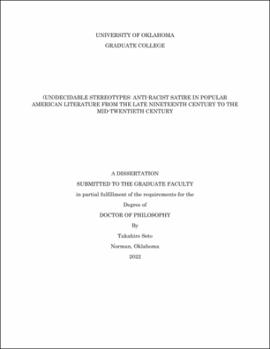| dc.description.abstract | This dissertation examines the satirical strategy that employs racial stereotypes to critique racism. I read the work of Mark Twain, Bret Harte, Charles W. Chesnutt, Dorothy Parker, and Langston Hughes and explore how this strategy effectively functioned in specific situations. The satirical pieces I selected represent racial others in a seemingly stereotypical manner. However, their stereotypical characters often contradict the public's images of racial minorities. Thus, by using (un)familiar stereotypes, anti-racist satire reveals the contradictory nature of racist stereotypes and encourages its audience to unlearn racial biases. This strategy can be particularly effective in the realm of popular literature which helped produce and circulate stereotypical images of racial others. The selected satirists, who were typically deemed popular writers, published their work in popular literary venues such as literary magazines, theaters, and newspapers. Their work might have disrupted the chain of racist stereotypes from within the literary industry. To infer how they were read by their contemporary readers, I also explore contextual and relevant materials such as magazines and contemporary reviews and reconstruct the specific reading situations. By doing so, I discover how the satirical texts are designed to effectively address the specific audiences. Such specificity helped mitigate the risk of backfiring and teach the audiences how the racial issues illustrated in the texts were relevant to them. At the same time, the contemporary audiences did not necessarily acknowledge the ironies in the satirical pieces. As a result, the stereotypes that were meant to be ironic possibly circulated as racist entertainment. This finding provides insights into how the ironic stereotype could also be an unstable means to satirize racism. Therefore, even if an anti-racist text only mentions or ironizes racial stereotypes for a critical purpose, there remains the risk of backfiring. This is the dilemma this dissertation repeatedly encounters: Is the ironic stereotype an effective tool for anti-racist purposes? Or is it just another racist stereotype? | en_US |

